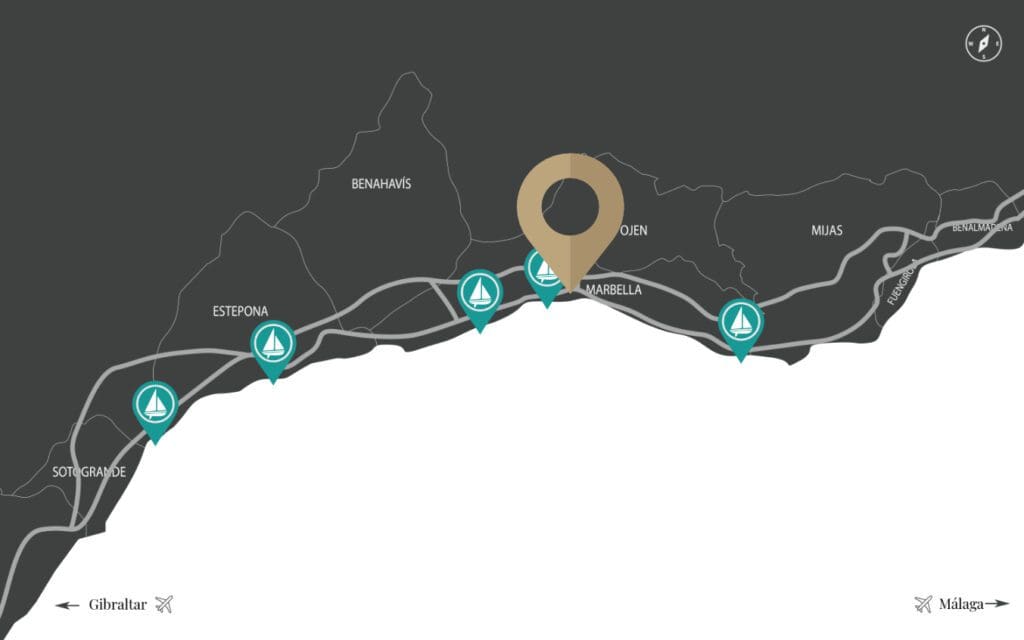
Marbella has been a prominent spot on the global map of glamorous, luxurious destinations since the 1950s, when the first jet-setters arrived on these sunny shores, but what it is that makes this town at the heart of the Costa del Sol so sought-after among those with the means to travel anywhere in the world?
Marbella has a reputation as a glamour spot that attracts people from all over the world. It is an appeal that is hard to define until you breathe its air, survey the natural beauty of its surroundings in that gloriously golden light and sample a way of life that is, quite frankly, hard to replicate elsewhere. Above all, Marbella is a canvas for your preferred lifestyle, be it on the golf course, sailing, socialising, imbibing culture or rambling through nature – and it is this that is the true essence of its enduring desirability.
Location
Marbella’s appeal is of course in large part due to its unique setting on the south coast of Spain, a microclimate produced by mountain ranges that shelter the coastal strip, and the natural beauty and spectacular views this combination of factors produces.
Set roughly midway between Gibraltar and Málaga, at 45 minutes from their international airports, the municipality of Marbella covers an area of 117km2, incorporating the city of Marbella itself, the small town of San Pedro Alcántara, some five kilometres to the west, and almost 45 kilometres of coastline. Several rivers running down into valleys and the coastal strip from the nearby mountain ranges flow into the Mediterranean Sea, which has historically formed the focal point of life in this region.
Originally inhabited by Iberians, the indigenous people of the Iberian Peninsula, this coastal area was settled by Phoenician traders some three thousand years ago, who founded cities such as Málaga, Cádiz and also Gibraltar. Celts, Romans and Germanic tribes followed, before the region formed the base from which Muslim conquerors invaded Spain and Portugal in the 8th century, remaining in this part until the end of the 15th century. Following their departure, Barbary Corsairs pillaged the shoreline for centuries, abducting tens of thousands of people to the slave dens of North Africa.
It was with the French conquest of Algeria in 1830 that this practice ended and agricultural villages such as San Pedro Alcántara became a possibility. Agriculture prospered in Marbella from this time onwards, along with iron ore mining, until the first jet-set visitors arriving in the 1950s transformed the region, and tourism and property development became pillars of a local economy that now operates throughout the year – long since transcending the seasonality of typical tourist towns. The famed climate of Marbella produces some of the sunniest and finest weather in Europe, making a year-round outdoor lifestyle possible.
Characteristics
Marbella is divided into several distinct parts:
Marbella Town is located roughly at the centre of the municipality. It is in many ways a typical Andalusian city with medium-tall buildings lining a main avenue, Ricardo Soriano, which divides the beachside and inland parts of town, the latter of which is also home to the wonderfully picturesque historic centre, known in Spanish as the Casco Antiguo. Largely car-free, its cobbled streets and squares are lined with charming shops, cafés and restaurants within the embrace of historic Moorish town walls. The old town is one of the most beautiful parts of Marbella, yet within a stroll from the town’s long line of sandy beaches, a sports marina and fishing harbour.
A palm-fringed avenue known as the Golden Mile links the town with the glamorous marina of Puerto Banús, whose luxurious yachts and floating palaces are surrounded by luxury brand boutiques and jewellers, as well as restaurants, cafés, nightclubs and, a little further along, the large El Corte Inglés department store. Puerto Banús is also known for its beaches and trendy beach club venues, and forms one of the key landmarks of the area known as Marbella West.
Here you will also find the luxurious villas, mansions and penthouses set on or near the Golden Mile, the hillside suburb of Sierra Blanca and Nueva Andalucía, Marbella’s largest suburb and home to many of its finest villas and luxury apartment complexes. The latter overlook the lush greenery of the famous championship golf courses of Las Brisas, Aloha and Los Naranjos, which together make up the so-called Golf Valley of Marbella.
A few kilometres further west is the little town of San Pedro Alcántara, a former agrarian colony but now one of the reference points for residents in the greater Marbella area. Home to some 20.000 people – around 10% of Marbella’s total population – it is the local town for luxurious residential suburbs such as Guadalmina, the furthest extension of Marbella on the border with the municipalities of Estepona and Benahavis.
Marbella East is the further outward projection of the town, adding a great deal of territory in an area that is still less developed yet features renowned residential zones such as Río Real, Los Monteros, El Rosario, Elviria, Las Chapas and Cabopino, home to the smallest but also most charming yacht harbour within Marbella. Close by are the coastal umbrella pine groves, dune landscape and long sandy beaches that this part of Marbella’s coastline is famous for.
Not surprisingly, Marbella East is dotted with charming fish restaurants and beach clubs, each with its own ambience and perspective of the sea. Exclusive Los Monteros has some of the finest examples of luxurious frontline beach villas in Marbella, with private access to the shore. The area is also home to a popular rugby club, while on the other side of the coastal road new villa suburbs follow a series of golf courses into the hills – amid spectacular country and coastal views.
Many of the properties in Marbella East find themselves ensconced within the cooling shade of protected pine groves, close to Marbella but also enjoying local amenities in the form of shops, supermarkets, banks, clinics, international schools, restaurants, cafés, nightlife and sport clubs. The area ends just past Cabopino, where the suburbs of Calahonda mark the beginning of the also large Mijas municipality.

Marbella and Beyond offers you instant access to the best property options on the coast, with skilled and experienced property asset advisors, lawyers and wealth management experts.
Marbella & Beyond will arrange a property tour that matches your lifestyle choices, leaving you free to explore your exciting new surroundings while we prepare the very best property portfolio and pocket listings in the area of your choice.
As well as having access to all the Marbella properties commonly available on the most popular property portals and the latest exclusive listings in the best addresses, we have numerous “pocket listings” properties not available on the open market, including high-end developers’ prerelease portfolios.
Unrivaled legal, tax and wealth advice through our team of experts as well as access to some of the best lending rates available.
*a pocket listing is a development or property the owner does not want to appear on websites or property portals.

I will be back soon